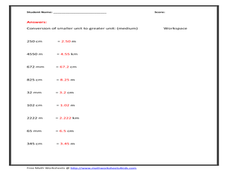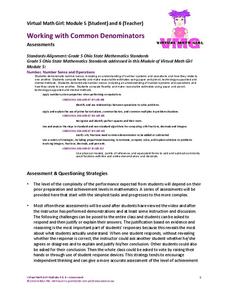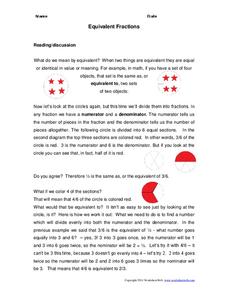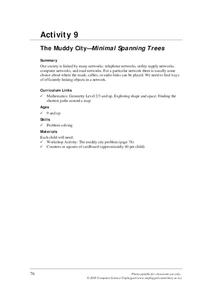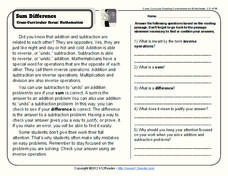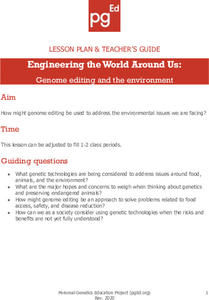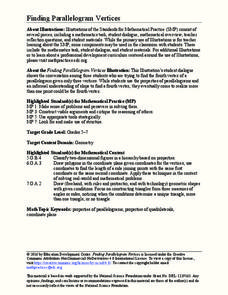Curated OER
Analogies
In this analogy worksheet, students answer seven questions using their problem solving skills and vocabulary skills to discover how words are related to each other. Students are encouraged to use dictionaries.
Curated OER
Idiom Sentence Maze
In this idiom sentence maze worksheet, students use problem solving skills to work their way through the maze by stringing together idiom sentences.
Curated OER
Money Amounts: Worksheet 3
In this counting coins worksheet, students use their problem solving skills to list as many different coin combinations as they can to total 88 cents.
Curated OER
Pascal's Hearts
In this math patterns puzzle worksheet, students practice their problem solving skills as they complete this math patterns puzzle.
Curated OER
Ant to Apple Letter A Maze
In this letter A maze instructional activity, students use their problem solving skills to find path for the ant through the maze and then trace the uppercase and lowercase letter As.
Curated OER
Year 5: Percentages (2)
For this percents practice worksheet, students use their problem solving skills to respond to 11 questions that require them to calculate the percents of the given numbers.
Curated OER
Convert Cents into Nickels Level 1
In this counting coins worksheet, learners use their problem solving skills to convert 18 monetary amounts listed in cents to monetary amounts in nickels.
Curated OER
Standard Metric Units - Length
In this units of measure conversion instructional activity, students use their problem solving skills to convert the 9 metric measurements listed to the assigned metric units.
Curated OER
Aggregate Demand and Supply Worksheet
In this economics worksheet, students use their problem solving skills to respond to 12 questions relating to aggregate supply and demand.
Curated OER
Scott the Painter
In this algebra worksheet, students rewrite a word problem using algebraic symbols. They create a table to figure out what rooms should be painted first and in what order. There is an answer key to this problem.
Curated OER
Product + 1: Integers
In this integers instructional activity, students solve 1 word problem using proof. Students prove their hypothesis of the result of multiplying four consecutive positive integers and adding one to the product.
PBS
Working with Common Denominators: Assessments
Now that the practice is over, see if young mathematicians can utilize their new skills on finding common denominators and adding fractions. The assessment contains one map challenge and follows with skills practice.
Education Development Center
Making Sense of Unusual Results
Collaboration is the key for this equation-solving lesson. Learners solve a multi-step linear equation that requires using the distributive property. Within collaborative groups, scholars discuss multiple methods and troubleshoot mistakes.
EngageNY
Comparison Shopping—Unit Price and Related Measurement Conversions II
Which rate is greater and by how much? Pupils continue to compare rates to solve problems in the 20th portion of a 29-part series. Rates are presented in a variety of representations either using the same representation or different...
California Education Partners
Animals of Rhomaar
Investigate the growth rates of alien animals. Pupils study fictional animals from another planet to determine how much they grow per year. The investigators plot the growth of their animals over a period of time and then compare...
Worksheet Web
Equivalent Fractions
Learn how to identify equivalent fractions by using divisors. After reading and discussing the skill, young mathematicians solve two problems using visual fraction models, and then solve eight equivalent fraction problems...
Computer Science Unplugged
The Muddy City—Minimal Spanning Trees
What is the most efficient way to ensure everyone is connected? Individual pupils determine the least expensive route to pave roads in a fictional city. In doing so, they learn to find the minimal spanning tree for the situation. They...
K12 Reader
Sum Difference
If you need a way to address math and reading in one lesson, look no further than a passage about inverse operations, complete with reading comprehension questions. Kids focus on context clues to determine the meanings of unfamiliar words.
Personal Genetics Education Project
Engineering the World Around Us: Genome Editing and the Environment
Challenge young minds to build a better world with genetic engineering. Biologists learn potential solutions for environmental issues using genome editing while interacting with three case studies. Scholars read articles and view...
Education Development Center
Rational Exponents
It's rational to root for your class to learn about exponents. Scholars study rational exponents by reading a fictional dialogue between classmates. They analyze the conversation to understand the connection between rational exponents...
Flipped Math
Unit 10 Review: Quadratics
Everything one wanted to know about parabolas in one place. Pupils work 27 problems as a review of the unit on quadratics. Problems range from determining key features of the function and using that information to graph the parabola, to...
Teach Engineering
What's Wrong with the Coordinates at the North Pole?
Here is an activity that merges technology with life skills as individuals use Google Earth to explore the differences between coordinate systems and map projections. The self-guided activity is the fourth segment in a nine-part unit....
Charleston School District
Pre-Test Unit 1: Exponents
How much do you know about exponents? The pre-test covers the concepts of integer exponents with both numerical and algebraic one-variable expressions. The test is also over representing numbers in scientific notation, operating with...
Education Development Center
Finding Parallelogram Vertices
Four is the perfect number—if you're talking about parallelograms. Scholars determine a possible fourth vertex of a parallelogram in the coordinate plane given the coordinates of three vertices. They read a conversation...







